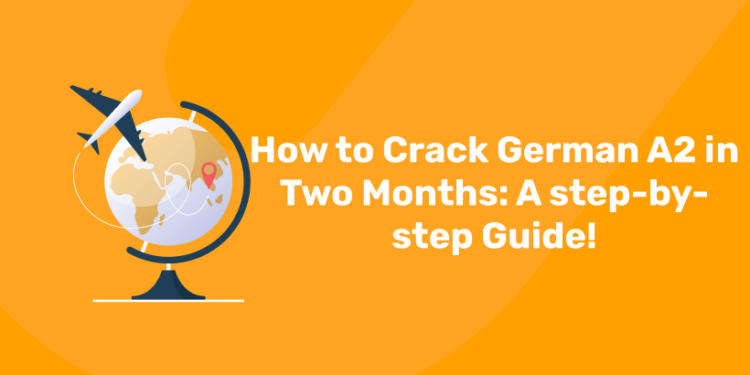Table of Contents
A2 is the level of the Common European Framework of Reference for Languages, a set of proficiency standards used by educators in German and many other languages. There are two levels of CERFL “Basic”.
So if you use CERFL, how good does your German have to be to pass Goethe A2? In short, you must be able to:
- understand sentences and commonly used expressions related to topics that directly relate to your immediate circumstances (e.g. personal data or information about your family, shopping, work, and immediate surroundings);
- understand each other in simple, routine situations involving a simple and direct exchange of information on familiar and common topics;
- describe simply your background and education, immediate surroundings, and other things related to immediate needs.
If you manage to pass the A2 German test, you have every reason to be proud of your success.
You will discuss many of the most frequent German grammar patterns. You should aim for a vocabulary of around 1300 words. With an active command of many of these words and patterns, and a passive understanding of more of them, you can expect to be able to handle some important real-life situations well when traveling.
Overall, you have developed an amazing skill that will help you connect with German speakers around the world and transform your experience in Germany, Austria or Switzerland.
Learn German language in your own language! Get free Demo Classes Here!
Where can you take the German A2 exam?
Unlike the B1 and B2 exams, which consist of four modules that you can take in separate sessions (even in separate exam centers).
The number of exams offered per year will vary from center to center. Some centers conduct the exam only once or twice a year. Larger and busier institutes such as Berlin may offer several sessions per month. The price also varies from country to country. Exams are also offered by foreign partner institutions.
|
German A2 Exercises – Download Free PDF |
||
The A2 exam requirements
German language proficiency level A2 (Goethe-Zertifikat), allows you to do this
- Name and understand numbers, prices, and time
- Fill out questionnaires with personal data
- Identify relevant information in written texts
- Introduce yourself and loved ones
- Conduct short dialogues in everyday situations
- Ask and answer simple personal questions
- Formulate and respond to requests and requirements.
The Goethe German A2 exam confirms elementary knowledge of the German language and corresponds to the first level (A2) on the six-level scale of the Common European Framework of Reference for Languages (CEFR).
The German A2 exam format section by section
The Goethe German A2 exam is split into four parts. These cover the four skills of listening, reading, reading and writing. There isn’t a separate grammar or vocab test (unlike, for example, in the Russian TRKI exams).
Let’s look at the format of each section in turn. Always check the most up-to-date format for yourself before the exam in case things change.
Reading Section (Lesen)
The total time is 30 minutes
The reading test is divided into four sections (Teil Eins bis Teil Vier). There’s only one correct answer for each.
Reading Part 1 (Teil Eins):
You get a text of about 180 words. In the model paper, this is a newspaper article: “Ich versuche immer wieder etwas Neues”. Of course, the text will be different in the exam.
You are then presented with five short, uncompleted statements about the content of the text and have to choose from options (a), (b) or (c) to complete the sentence. To stress: the sentences are not lifted directly from the text. You can’t just play “spot the same string of words”, so your understanding of the text is really tested.
Reading Part 2 (Teil Zwei):
The model paper presents you with an information board from a department store (the sort of thing you’ll often see by the stairs or the lifts telling you what’s on sale on which floor).
For each of the five questions, you have to choose which floor you need.
Just as with Reading Part 1, a range of different vocab’s going to be tested. You can’t just rely on the vocab in the extract. So, the illustrative example in the model paper is “Sie suchen ein Sofa”. The answer is “2. Stock”. The challenge is that there’s nothing about “Sofas” on the sign under 2. Stock. What it does say is on the 2. Stock is “Möbel für Wohnzimmer, Bad und Küche.” You’ll need to recognise at least “furniture for living room…” to be able to answer the question.
Reading Part 3 (Teil Drei)(10 minutes):
In the model paper, the text is an informal email about 250 words long. Like in the first two questions, there are five statements that you need to complete to test your understanding.
Reading Part 4 (Teil 4):
In the model paper there are seven short internet info pages (each about 30 to 40 words) from cafés / caterers. You have to match the internet page that’s the best fit with the five seekers, e.g. (q. 16): Sarah heiratet bald und möchte mit vielen Gästen in einem Lokal feiern”.
Listening Section (Hören)
The total time is 30 mins
The listening section of the A2 test in German exposes you to a range of different speakers (ages, accents) and to different registers of language. In the model exam, these are radio broadcasts, a message on telephone answering machine and a loudspeaker announcement.
The sample recordings to the model paper are perhaps clearer than real speech would often but but the pace seems to me to be generally to be realistic for slower end of normal speech .
The whole soundtrack for the model exam is on the Goethe website.
You’ll hear the instructions for each Teil as it begins. These are much slower than standard speech and are the same as the written instructions for each Teil that you’ll have on front of you on the exam paper.
Let’s look at the four sections in a detail!
Listening Part 1 (Teil Eins):
The recording lasts roughly seven and a half minutes, including audio instructions in German (the same as is written on the paper).
There are five questions.
Before each question, there’s a pause of roughly fifteen seconds for you to read the question (the questions are short).
There are three radio clips (one is a weather forecast), two answer machine voicemails.
For example, question three is “Wo findet das Treffen statt? There are three options: a) Am Bahnhof, (b) Im Büro and (c) Im Hotel Leopold. If you were just listening out for individual words and guessing, it would be easy to get this one wrong. The women leaving the message explains that today’s meeting won’t be taking place “im Büro” but “im Hotel Leopold am Bahnhofsplatz”. She explains that there was a mistake on the invitation.
There’s another fifteen or twenty second gap at the end of question five.
Listening Part 2 (Teil Zwei):
In the model paper, Teil 2 is a conversation that you get to hear just once, a couple (man and woman, talking about how they’re going to spend their week’s holiday). There are eight pictures on the exam paper and you have to match the activities pictured to one or five days of the week (that’s to say, what’s happening on Dienstag, Mittwoch, Donnerstag, Freitag and Samstag).
First you get about thirty seconds to look at the pictures, when you could think of some of the vocab that might be coming up to describe what you can see.
Then you hear the example question (there’s an nineth picture of people in a cinema, Monday’s activity).
There are eight pictures and you’ll only need five of them. You’re told that you shouldn’t choose a picture more than once.
You hear the whole conversation without pauses. It’s about one minute long.
Listen carefully as you could easily be led astray. For example, picture (a) is of people dancing and the women says that they’ve got their dancing class on Tuesday. If you hear “Tanzkurs” you might think that (a) is the answer, but the man replies that the teacher is away this week too, so there’s no class. For Wednesday, the man suggests a trip to the swimming baths (picture (c)) but the woman says she would prefer to go cycling (picture (g)), which is what they agree.
At the end of Teil 2, there’s another short pause (about fifteen seconds).
Listening Part 3 (Teil Drei):
You hear five short conversations (man and woman) just one.
Before each conversation there’s a fifteen or so second pause for you to read the question and look at three pictures. The first, question, for example is “Was hat das Mädchen gestern Abend gegessen?” There are three pictures: plate of fish, hamburger, plate of chicken. She mentions all three but says she chose the chicken.
There’s another pause of about fifteen seconds at the end of Teil Drei.
Listening Part 4 (Teil Vier):
The recording is a radio interview between the male host and female guest.
There are five questions about what you’ve heard and you have to choose “ja” or “nein”.
First you get a little under thirty seconds to read all five questions.
Then you hear the interview twice. It’s about a minute long and it’s played the second time with only a very short pause, so I think it would make sense to answer the questions as you go (and double check, deal with any gaps on the second hearing).
There’s another short gap and then you’re asked to copy your answers for all four Teile on the answer sheet.
Writing Section (Schreiben)
The total time for the Writing Section is 30 minutes and you can allocate the time as you wish between the two tasks. All the instructions are (as throughout the whole exam) in German only. So, your reading will be tested quite a bit before you can start writing.
Writing Part One (Teil Eins):
You have to write a text message of 20 to 30 words. The scenario in the model paper is that you are underway in the town and message your friend. You have to excuse yourself that you’ll be arriving late, explain why and specify a new meeting place and time. You should cover all three points.
In the “real” exam the task would presumably be similar (whether or not in the form of a text?): three points to be covered, 20 to 30 words.
Writing Part Two (Teil Zwei):
You have to a write 30- to 40-word email. In the model paper the scenario is that your boss has invited you to his birthday party. You must reply, thanking and accepting, explaining that you’ll be bringing somebody with you and asking the way to the party.
Speaking Section (Sprechen)
The total time is fifteen minutes, during which you are examined with another candidate, your “Partner” or “Partnerin”.
Speaking Part One (Teil Eins):
This is a question and answer exchange between you and your Partner.
In the model paper, it says that you’ll be given four cards with the following prompts: “Geburtstag?”, “Wohnort?”, “Beruf”, “Hobby?” The task is to formulate questions on the basis of these prompts and your partner has to answer them. Then your partner will do the same. It seems from the model paper that you both get the same four prompts.
The challenge here, then, if you’re the “asker” is to turn the prompt into a brief question.
When it’s your turn to answer, I would imagine that a short phrase or two is going to be more impressive than a one word response (but don’t tie yourself up in knots).
Speaking Part Two (Teil Zwei):
Part Two is “Von sich erzählen” (sharing information about yourself). It’s a monologue and you both have to talk about a different personal topic.
Partner A gets the question “Was machen Sie mit Ihrem Geld?” There are four prompts, potential answers: Kleidung? Lebensmittel, Miete? Sparen? Reisen?
Partner B gets the question “Was mach Sie oft am Wochenend? Prompts: Sport,…? Jemanden besuchen? Mit wem? Wo?”.
Speaking Part Three (Teil Drei):
Speaking Part Three is a two-way discussion task is to agree on a time when you can both go and buy a birthday present for your mutual friend Patrick. You are both given a copy of your personal engagement diary for Saturday with various time slots blocked out for various activities, such as “Frühstück bei Mario”, “Eltern anrufen” or “Schwimmen”.
Though neither of you know it, there is only one slot between 7 am and 10 pm that you are both free and that’s 5 pm to 6pm.
So, you need to ask back and forth whether your Partner can do a particular time and they will need to explain what they’ll be busy with, until you hit on the time.
If one of you suggests 5pm right off the bat, the conversation could be quite short. On the other hand, it could take quite a while to hit on the time.
Ready to take your German language skills to the next level? Get Free Demo Classes Here!
How to Pass the A2 German Exams in 6 Steps
1) Don’t focus on just one aspect of the language
Most of us today communicate via text messages, email and social media – all of which we need to know how to read and write in order to use them.
Not to mention how simply focusing on one aspect of the language severely limits your access to the world of the second language. Just think about how much you speak, listen to, read and write in English on any given day. Now imagine doing just one of these things all day. Then every day. It’s not a very interesting world now, is it?
Any experienced learner will tell you that the more aspects of a language you use, the more likely you are to get used to it and therefore learn it naturally. This is because children do not learn language in only one way. They grow up listening to it, then they see it on signs and papers and things around them, then they talk it to their parents, and at school they go on to write their names and thoughts and so on. They have years of full-time exposure before they say their first word. You too will learn faster and better when you engage with the language on all fronts.
That is why standardized language tests such as those from the Goethe Institut are comprehensive. You will need to balance your language skills to master them. Yes, you’ll probably be better at one thing than another, but your levels shouldn’t be far apart. If you take a practice test and find that a skill is seriously lacking, don’t let it slide.
2) Use it or lose it!
You should study or review every day. But if you can’t do that, you need to fit it into a regular time slot in your schedule and stick to it.
This is especially true when you’re just starting out—the basics are the hardest and most important. It takes time for your brain to get used to the look and sound of a foreign language, and time for those basics to stick. You can’t skip it – but if you put your brain to it, you’ll become more familiar with your tongue and it will flow naturally out of your mouth like magic.
don’t waste your time and effort by lazily reducing your revision and study time. I’ve done it too many times and always regretted it. If you take too much time in between, your foundation will disappear. Then you’ll have to start over to get it back. It is not worth it!
I like to set a 25-minute “Pomodoro Timer”, also known as a Tomato Timer. While there is some science behind it, the 25 minute limit works for me because it’s only half an hour, which sometimes sounds like too much time to do one thing. After the timer runs out, I often find myself thinking, “Wow! Already?” and continue for another cycle or two.
3) Work on your accent
Have you ever heard an accent so bad it hurt your ears? I did. When I did the speaking test at A2, I could barely understand my partner’s German accent. I had to keep asking him to repeat himself and even the test proctors looked confused. I’m sure he didn’t pass.
Even though my speaking partner’s vocabulary was huge and his grammar perfect, he had such a bad accent that no one understood him – and I’d even say no one wanted to. You don’t want to be like that guy, do you?
As with all things, you won’t sound like a native with every word from the start, but there are a few things you can do to get yourself on track. Aside from what you already know you should be doing (like listening to and imitating native speakers), the real key to a German or any other accent is the mouth.
How someone moves their mouth shows how they make the sounds of their tongue. You can just look at someone’s mouth and tell what language they are speaking.
Check out this video from Easy German (fantastic YouTube channel). Watch Cara’s mouth. Notice how you almost always see her front teeth and how her teeth never touch her lips like they would in English. The Germans speak from the front as if they were about to whistle.
All in all – if you want to sound German, your mouth should move like a German. Watch and imitate the mouths in the videos above and then approach the words in your textbooks in the same way and so on. You will immediately notice an improvement in your pronunciation and German words will be much easier to pronounce.
4) Invest in a good textbook!
The most important thing on your journey through the language A1-A2 and beyond will be the firm and guiding hand of a good old textbook.
Yes, a physics textbook. One you can flip through the pages, one you can hold in your hands, mark with sticky notes and highlighters; one with practice questions and dialogues, grammar explained, the whole nine yards.
That’s not to say I don’t like apps—well, I don’t—but they should be considered supplements to a good textbook. Or in addition. Or additional practice. I suggest some solid apps below, but the fact is that no app can replace the comprehensiveness of a physical textbook (with well-made audio CDs!).
The main reason I like textbooks is that when you’re just starting out with a language, especially your own, it’s overwhelming – What words should you learn first? What grammar? What should I know how to say at this level? A solid introductory textbook answers these questions and more, giving you plenty of listening, reading, grammar and even speaking practice.
Now there are a lot of textbooks, some good and some bad and some really really bad. But luckily for you, I consider myself a bit of a textbook ‘connoisseur’ and have two that I’ve used in particular to prepare for the A1 and A2 exams.
5) Get a tutor!
You should find a teacher, not a friend, and pay them regularly. In this way, you are always guaranteed one hour of German per week and you can have what you say and write corrected by a fluent speaker.
Also suggest finding a bilingual tutor so you’re not crippled with fear and ask a question when you get stuck.
6) Stay! In! Your! Lane!!
One of the biggest reasons I insist on getting a physical textbook to use as your primary language resource is that you can adapt and gradually build your skills and vocabulary. Otherwise, you’ll get lost trying to figure out what you should be learning at your level and just try to do too much.
You have to accept that you are not yet as good as you want to be, but know that you will be if you take it easy and work your way up. This is difficult for many people because it is natural to want to know everything from the beginning.
Tips for Success in German A2 Online Courses
Time Management Strategies
Success in an online course requires effective time management. Setting aside dedicated study time, breaking the curriculum into manageable sections, and staying consistent are essential components of success in online A2 German courses.
Utilizing Online Resources Effectively
Online resources are abundant on the platforms. Students should use forums, discussion groups and supplementary materials to deepen their understanding and connect with other students to make online German A2 courses more engaging.
Understanding the German A2 Level
The Common European Framework of Reference for Languages (CEFR) categorizes language skills into six levels, from A1 (beginner) to C2 (proficiency). German A2 is right in the middle, making it a crucial point in your language learning. At this level you will be able to:
- German A2: Build confidence in your language skills – Progressing from A1 to A2 will give you the confidence to engage in more complex conversations, both written and spoken. You can express your thoughts and feelings more effectively.
- German A2: Expand your vocabulary – At A2 you will find that your German vocabulary is constantly growing. You can easily talk about everyday topics like family, hobbies and travel experiences.
- German A2: Gain better comprehension – You will also understand German speakers better and be able to follow more extensive dialogues, allowing you to immerse yourself in the language more effectively.
German A2: Tips for Success
Achieving success at the German A2 level requires dedication and focus. Here are some tips to help you on your way:
- Structured Learning: –Enroll in a structured German course or use language learning apps and resources specially designed for A2 level.
- Daily Practice: – Consistency is the key. Devote part of your day to language practice, including listening, speaking, reading and writing.
- Immerse Yourself: –Immerse yourself in the language as much as possible. Watch German TV shows, movies and news. Try reading books or articles in German that interest you.
- Language Exchange: – Connect with native speakers or classmates for a language exchange. Regular conversation in German can be invaluable for reaching A2 level.
- Set Goals: – Define clear language learning goals for your A2 journey. Specific goals help you stay motivated and measure your progress.
Pass marks and retakes
You must get at least 60% in each section to pass. If you fail a section and would like to retake the exam later, you will have to retake the entire exam. You can repeat the entire exam as many times as you like.
Benefits of Learning German A2 Online
Flexibility in Learning
One of the key advantages of choosing an online German A2 course is the flexibility it offers. Taking an online German A2 course removes the time and location constraints of offline classroom training, allowing students to customize their study plans to fit their busy lives.
Access to Qualified Instructors
Online German A2 courses often boast a team of experienced and qualified tutors who guide students through the intricacies of the German language. The virtual format allows for personalized attention and ensures that students receive valuable feedback and support.
Interactive Learning Materials
Modern German A2 online courses use a variety of interactive learning materials, including videos, quizzes and virtual exercises. These resources improve understanding while adding fun and excitement to the learning process.
FAQs
Is A2 German exam difficult?
German A2 exam pattern is quite simple. As it’s a language, there are 4 modules- Reading, Writing, Listening and Speaking. It is a 60 points exam and you have to score a minimum 36 points (60%) to pass the exam.
What is the A2 test in German?
The Goethe-Zertifikat A2 is a German exam for adults. It requires elementary language skills and corresponds to the second level (A2) on the six-level scale of competence laid down in the Common European Framework of Reference for Languages (CEFR).
How do I get an A2 German certificate?
You can sit the exam in Germany, at one of the Goethe-Instituts located around the world or with one of our exam partners situated in your area. Select the country in which you would like to take the exam to find out about the options available to you there.
Is A2 German enough to get a job?
In our blog today, we will show you some areas of work for which only level A1 or A2 German is required. In particular, for jobs with little or no contact with customers, a minimal level of German is generally sufficient.
Learn German language in your own language! Get free Demo Classes Here!











